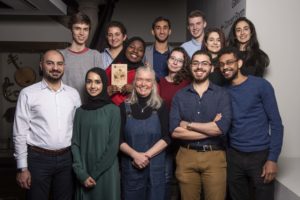Voices of the Planet: Jasmine Hussain, Singapore

We’re highlighting the impacts of climate change by sharing the first-hand experiences of staff, students and alumni, focusing on those in the global south.
Our first story is from Jasmine Hussain, an Ecological and Environmental Science student from Singapore.
A common view shared amongst Singaporeans is that ‘we are lucky’ to not experience the direct impacts of climate change. This might be attributed to our fortunate geography, meaning extreme weather events are unlikely to occur here or the fact that nearby countries such as Australia, have it far worse. However, while the impacts may not be so obvious, this ‘Garden City’ is certainly exposed to several threats.
Increasing Temperatures
One thing we share in common with the Brits, is talking about the weather. We in Singapore, love complaining about how hot and humid the weather gets. And it gets worse every year. Every summer break I’ve spent back home has felt hotter than the last. I once thought that this was because I had acclimatised to the cool (or rather, extremely cold) Edinburgh weather, but I found my friends and family to be experiencing the same. After a little bit of digging, I found that ‘13 of the past 15 years have been the warmest in Singapore’s historical record since 1929’. A recent article in PLOS ONE even suggested that ‘of all 22% of cities that will experience novel climate conditions, 64% are located in the tropics’ and these include Singapore.
Whilst an increase in temperature may not rouse anything more than complaints, there are serious considerations to make. Singapore is situated in a region where vector-borne diseases such as Dengue are endemic. Rising temperatures can lengthen the season and geographic range of disease-carrying insects. Cases of vector-borne disease in Singapore are also mostly observed during warmer periods of the year. Furthermore, Singapore experiences the urban heat island effect and higher temperatures can further enhance this. An increase in discomfort from the heat can also encourage increased use of air-conditioning, which are largely powered by non-renewable-energy sources in Singapore. This further increases our greenhouse gas emissions. Moreover, for a country that imports more than 90% of our food, we are particularly vulnerable to fluctuations in global temperatures that threaten the global food supply.
Changing rainfall patterns
Not only have temperatures become more intense in recent years, but the frequency and intensity of rainfall have increased as well. Incidence of flash floods has increased over the years and in January 2018, half of the month’s average rainfall fell within a period of 4 hours. Whilst local news articles rarely make the link between these floods and climate change, there is no doubt that our changing climate had partly contributed to these events. On the other hand, periods of meteorological drought have also become more intense for Singapore.

Supertrees at the famous Gardens by the Bay. These structures are up to 50 meters tall and harness solar energy to power a nightly light show. Their trunks are also home to more than 150,000 species of plants. Photo credits: Luca Locatelli, Institute
Public Perception and actions
A national survey in 2016 revealed that most Singaporeans were worried about climate change and its impacts on future generations. I personally remain sceptical of such information because being worried is one thing and acting on your worries and changing your behaviour is a whole other situation. The survey also revealed that more than 30% felt that their individual actions would not make a difference.
From observation, many Singaporeans do not recycle, single-use plastic consumption is very high and not many people consciously commit to reducing their personal footprint from meat consumption or travel. Overall, I feel that conversations about the environment are lacking. For a tiny nation, it is rather shocking that Singapore ranks 26th of 142 countries in terms of emissions per capita. This is a comparison to Germany and the United Kingdom who rank 24th and 33rd respectively.
Looking to the future
So what are our solutions?
Renewable energy options are limited in Singapore due to our low wind speeds, low tidal range and complete lack of hydro resources. Solar energy remains the most viable option however, limited space inhibits its large-scale development. Our waste gets incinerated due to the lack of available land for landfills, contributing further to our emissions.
If we can’t deal with the problems after, we have to look towards preventing them first. Behaviour change is the most challenging yet most effective solution to addressing our current climate problems. Simple actions include – bringing your own containers when taking food to-go, using a reusable coffee cup, taking a bus instead of a taxi or eating lower down on the food chain. If you’d like to make an even bigger impact: reconsider your holidays – Do you really need to fly? Is there a lower carbon option? Can you offset your travel emissions?
It is easy to say that climate change is not a problem for us to deal with as its impacts might not be so visible. But it is, in fact, a problem for the world to deal with and developed countries like Singapore, should be taking more responsibility.
Keep up to date with the Department for Social Responsibility and Sustainability by following us on social media.
Check out Jasmine’s personal blog, we particularly recommend her content under the “Sustainability” tab!





Recent comments